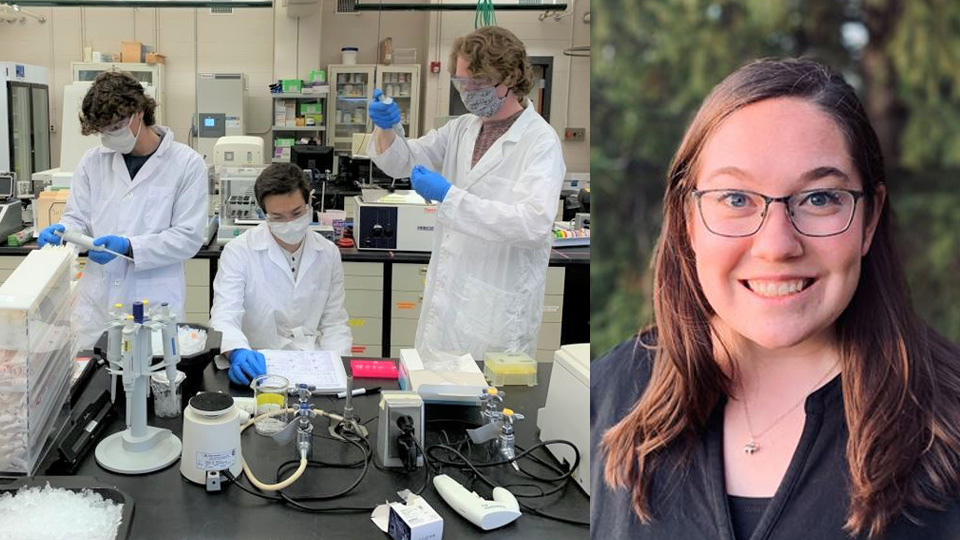High School Students Uncover New DNA Sequences
Subscriber Benefit
As a subscriber you can listen to articles at work, in the car, or while you work out. Subscribe Now
A recent DNA discovery means four Hoosier high school students are published scientists at the young age of 18. While COVID wreaked havoc on students’ senior years, Noblesville High School teacher Caitlyn Foye got creative with the closures and brought cutting-edge research to her classroom. The students uncovered four new gene sequences—a discovery so rare in a high school classroom that when Foye first submitted the data for publication, the governing body assumed it was part of a theoretical lesson for her class and requested she no longer send “hypothetical submissions.” The hiccup was resolved, and the four-student team cracked the code on how to graduate as published scientists.
“It’s an awesome feeling,” says Josh Middleton, who is now a freshman at Purdue University. “My oldest brother finished his masters recently, so I like to joke with him that I’m published, and he’s been in college all these years and hasn’t been published yet.”
The idea took shape when Foye, who worked in a genetics lab before becoming a teacher, scrambled to find a replacement for the internships—typically at medical facilities—that are supposed to conclude the Project Lead the Way Biomedical Science four-class sequence.
“This was something the students had looked forward to for, essentially, four years at that point,” says Foye. “They were really, really disappointed; it felt like something else that was being taken away from them with Covid.”
Determined to create a valuable lab experience that would match the rigor of an internship, Foye arranged for Middleton, Joshua Lamantia, Brayden Colon and Steven Kozakiewicz to analyze plant DNA that’s involved in converting food into a usable form of energy for a cell. The team of seniors ground ferns and mosses to extract their DNA, then used gel electrophoresis and PCR—common methods used in professional labs—to complete the analysis.
“A similar protein in our [human] cells has been found to…manage a lot of roles beyond the conversion of food into energy,” says Foye. “In plants, it’s been found to be very important to the immune response. That’s a very recent finding; this gene that was thought to have just this one role has actually been found to play multiple different roles within a plant.”
In addition to getting their hands dirty doing real-world lab work, Foye wanted the students to understand the entire research process—and that meant publication. Foye submitted the four new gene sequences to the National Center for Biotechnology Information, and after clearing the initial confusion that the data from high school students was only “hypothetical,” the sequences were verified and published. The students also wrote a scientific paper that’s being published in The Proceedings of the Indiana Academy of Science.
“For a high school student, that’s relatively unheard of,” says Foye. “It signifies that these students were contributing to the body of knowledge, not just in Indiana, but in this global database, which people have access to and submit new genes to every day from all across the world.”
“Once we got the results back, and we knew this was the first of its kind in the world, that was really exciting for us,” says Middleton, who is majoring in medical laboratory sciences. “[Foye] showed us that [coursework] doesn’t always have to be this basic step-ladder thing; you can really take it to the top as long as you are willing to put in the hard work to gain the knowledge. That’s been really big.”
As with most research, “you’re usually left with more questions than you have answers,” says Foye, so two new teams of current Noblesville students are now investigating two different pathways uncovered by the original research.
As for Middleton, Lamantia, Colon and Kozakiewicz, “we’re all working on research now as freshmen in college, which is not very common at all,” says Middleton. And that was Foye’s mission—to provide a stepping stone for their next accomplishment.
“This may have opened up their eyes to…the potential of a field in science and making a difference through the discovery of something new,” says Foye. “I think they’re going to be discovering the new science practices of tomorrow. I’m really excited to follow their careers and their futures and see where the world takes them; for these students, I think anything is possible.”
From the beginning of the project, Foye says was hopeful the students’ work could be published.
Middleton admits to being doubtful when his teacher pitched classroom research to replace the internship he’d been looking forward to, but he soon realized the value of their work.
